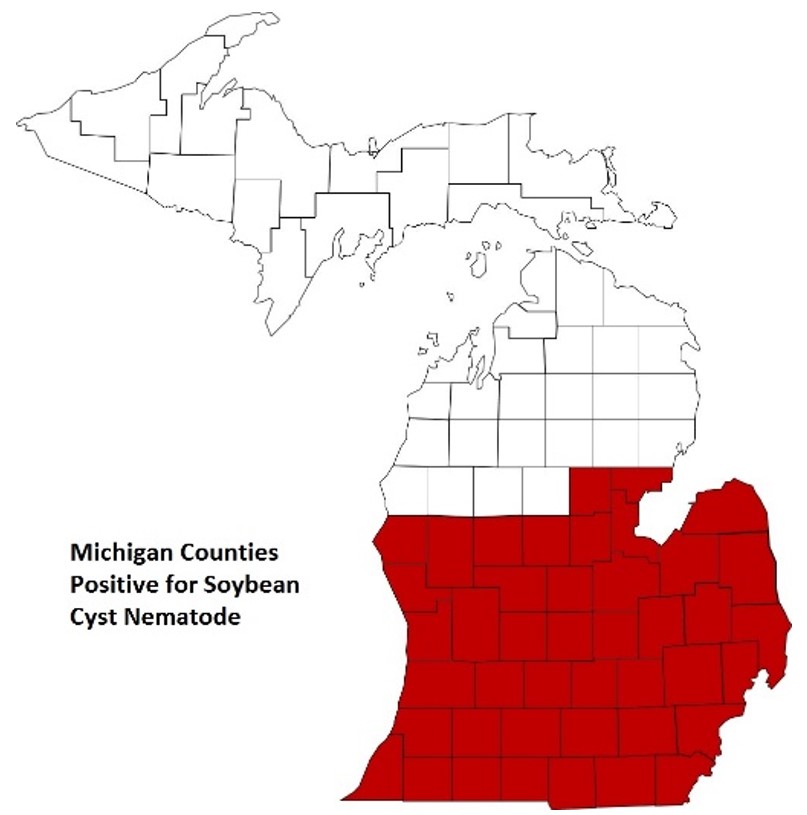Avoid significant yield loss in soybeans by sampling for soybean cyst nematode
Fall is the time to collect soil samples for soybean cyst nematodes to plan for next year.

If you have areas with lower-than-expected soybean yields that cannot be explained by typical production hurdles, it may be due to soybean cyst nematode (Heterodera glycines, Photo 1). This nematode is a major limiting factor in Michigan soybean production. Soybean cyst nematode is known to exist in all of Michigan’s major soybean producing counties (Photo 2). Soybean cyst nematode infestations can result in poor stands, stunted plants, yellow foliage and low soybean yields. Losses can range from 5 to 90 % of the yield potential. In addition to soybeans, other legume crops such as dry beans, snap beans and clovers can be hosts for soybean cyst nematode. It has also been known to survive on some winter annual weed species, such as henbit (Lamium amplexicaule) and purple deadnettle (L. purpureum).

Fall is a good time to sample for soybean cyst nematode in preparation for next year's soybean growing season, as monitoring is an essential part of nematode management. Early detection is critical in avoiding drastic yield losses and high population densities of soybean cyst nematode. Many Michigan growers rely on resistant soybean varieties to manage their soybean cyst nematode populations, with over 95% using breeding line PI 88788. Over the past seven years in Michigan, type testing, which determines the ability of soybean cyst nematode populations to overcome resistant soybean genetics, has shown that all our soybean cyst nematode populations have overcome the resistance offered by PI 88788 genetics. This reinforces that it is essential to monitor soybean cyst nematodes to prevent significant increases in population densities.

If soybean cyst nematode is detected (Photo 3), there are control options available to help mitigate its impact. Management tools and strategies include rotating sources of soybean cyst nematode resistance between PI88788 and Peking, rotating with non-host crops such as wheat and corn, and utilizing seed treatments when available. Soybean cyst nematode spread occurs by movement of infested soil. It is also important to clean equipment between fields to prevent soybean cyst nematode from spreading into uninfected fields. Combining these strategies will provide a comprehensive approach to managing soybean cyst nematode and minimizing its impact on soybean yield.
Sampling for soybean cyst nematode requires collecting roots, soil or both from suspicious fields and submission to MSU Plant & Pest Diagnostics. More details on the sampling protocol and submission process for soybean cyst nematode and other plant-parasitic nematodes can be found on the Plant & Pest Diagnostics website under Detecting and Avoiding Nematode Problems.
Yearly monitoring can help with early detection, informed decision-making, and customizing management plans to reduce yield losses. If you have questions about sampling for soybean cyst nematode or type testing, please contact Angie Tenney, nematologist at MSU Plant & Pest Diagnostics, at millera3@msu.edu.
This work is supported by the Crop Protection and Pest Management Program [grant no 2024-70006-43569] from the USDA National Institute of Food and Agriculture. Any opinions, findings, conclusions, or recommendations expressed in this publication are those of the author(s) and do not necessarily reflect the view of the U.S. Department of Agriculture.



 Print
Print Email
Email